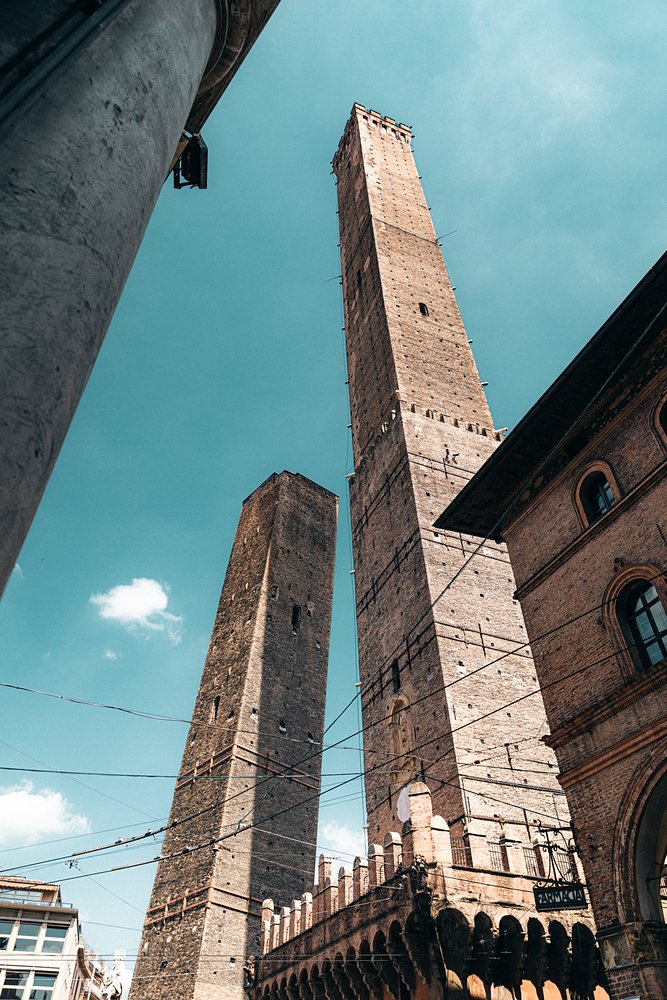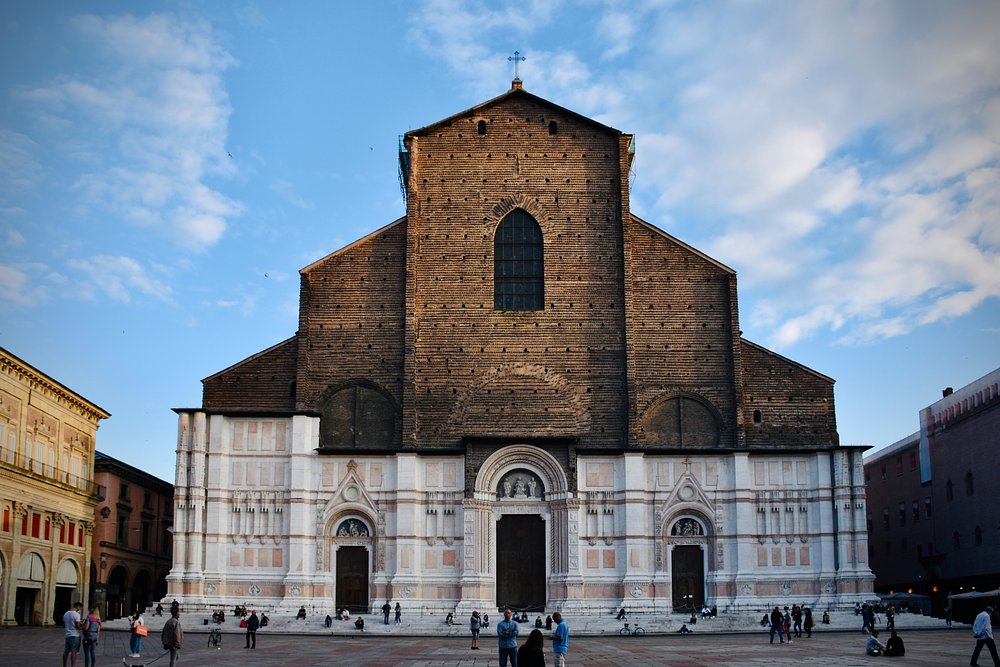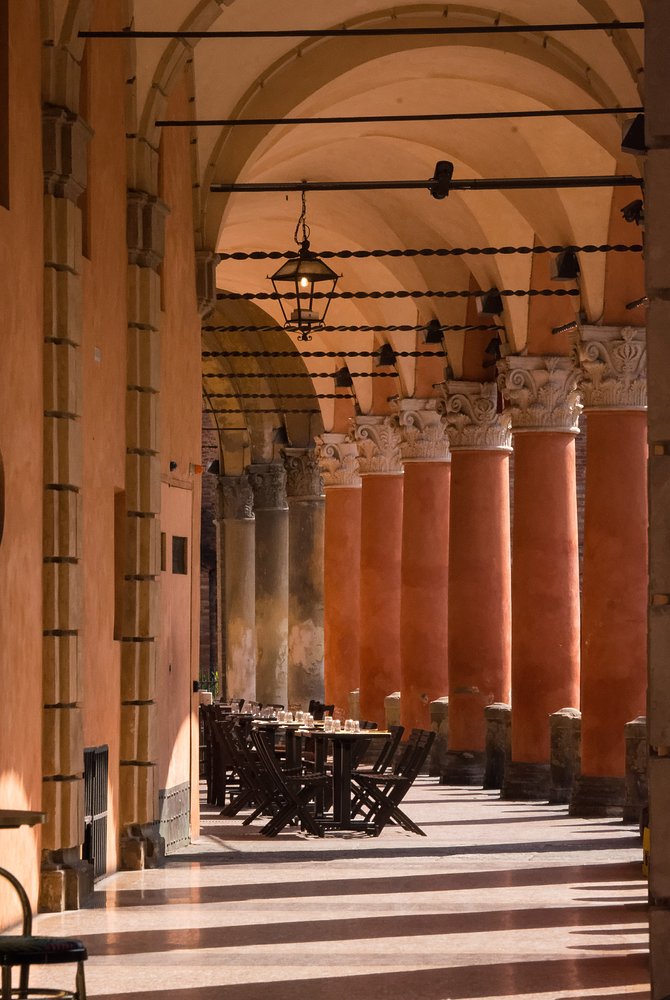The most important thing to do in Bologna is eat. Eat everything - Especially local specialties such as tortellini, gelato and mortadella. Bologna is known in Italy as La Grassa, or the fat one, and this city LOVES to cook and eat, so a big part of your trip should be seeking out and trying as much local food as possible. Just don't commit the cardinal sin of asking for Spaghetti Bolognese - they call it tagliatelle al ragù. Parmesan is another Emilia-Romagna creation, so be sure to sprinkle it all over your pasta!
Day One:
Climb the leaning tower - Built in the 12th century, Torre degli Asinelli and its shorter neighbour Torre Garisenda are the most recognisable symbols of Bologna. At 97.2m high, Asinelli tower is much taller than Pisa's wonky effort, though not as lean-y. Its smaller sibling tilts at a drunken 4 degrees, which IS steeper than the Tower of Pisa's incline. For that reason, it is (sensibly) closed to the public. To climb Torre degli Asinelli, you must pre book a timed entry slot (tickets are about 5 Euro), either online or at the visitor centre in Piazza Maggiore. It's a thigh burning 498 steps to the top, but you'll get amazing views from the top across the red tiled rooftops that give Bologna it's nickname, la Rossa, and over rolling green hills beyond the city limits.
Enjoy a coffee in Piazza Maggiore - this is the main square of Bologna, home to Basilica di San Petronio and the striking Fountain of Neptune. Surrounded by porticos, cafes and shops, this 13th century piazza is always lively - in summer there are often concerts and outdoor film screenings. Enjoy a coffee or Aperol Spritz while you people watch.
Visit San Petronio - Dedicated to the Patron saint of Bologna, this magnificent, massive church was built in Piazza Maggiore throughout the 14th - 16th centuries. It looks particularly striking as only the bottom third or so of the façade is clad in white marble - the rest is bare brick. Rumour has it that Pope Pius IV heard that the church was set to be bigger than the Vatican's St Peter's Basilica and blocked further funding. Inside, the organ dates from 1470 and is the oldest is the world still being used. You can also see the beautiful sundial meridian line designed by Cassini in 1655 to prove that the Earth orbits the Sun. Entry to the church is free, there is a small entry fee to the Chapel of the Magi where you can see an enormous fresco of Dante's visions of Heaven and Hell, complete with a huge two headed devil devouring sinners. The depiction of the Prophet Mohammed in Hell has proved controversial and has led to the church being targeted by Al Qaeda several times.
Sample some local cuisine on Via delle Pescherie Vecchie - this alleyway tucked in a district of narrow streets that was the commercial centre of Medieval Bologna is the perfect place to encounter the city's foodie heritage. Huge parmesan cheeses are stacked in windows alongside butchers, fishmongers, fruit and veg stands and pasta shops.
Dinner plans: Feel like a local at Osteria del Sol - Built in 1465, this is the oldest Osteria in Italy. Bring your own food and grab a seat at a long communal table. Glasses of wine are cheap and people often arrive with a boxed takeaway pizza, or some bread, cold meats and olives. It's the perfect place to camp out and people watch, munch and get chatting.
Finish the evening with a romantic stroll beneath the porticoes - the famous porticoes of Bologna add up to be nearly 40km long and have been nominated to be a UNESCO World Heritage Site. These elegant covered walkways were first built in the Middle Ages and added to until the 20th century, and are filled with cafes and shops, often beneath beautiful painted ceilings.
Day Two:
Take the road train up to San Luca Basilica - From Piazza Maggiore, a cheerful tourist train slowly makes its way up to the top of Colle della Guardia, through narrow streets and tree lined hills, following the route of the 3.5km portico (the longest in the world) that marks the pilgrimage route from the city to the basilica. You can also walk, but it is very long, very steep and often very hot - the 10 Euro ticket includes a return journey, but if you'd like to walk the 600+ arches of the portico, you could always ride up the hill and walk back down to town. The church itself dates from 1723 and is a beautiful coral pink with an impressive green dome. Views from the terrace stretch for miles.
Have lunch up there at Vito a San Luca - this restaurant is on top of Colle della Guardia, just along the road from the Basilica di San Luca. They serve very large, very good pizzas!
Head back down to Piazza Maggiore.
Peep through the Finestrella di via Piella - this small unassuming window on Via Piella allows a rare glimpse out over the hidden Canale delle Moline. Bologna once had as many canals as Venice, used for transporting people and goods such as silk and tobacco, but over the years they were largely all built over. This secret view feels like peeking back in time as the water flows beneath pastel coloured houses.
Walk through time at Basilica di Santo Stefano - wander through this intriguing labyrinth of churches through the ages. Santo Stefano is a complex of religious buildings rather than one church, built between the 4th and 13th centuries. The Chiesa del Crocefisso contains the bones of San Petronio, the bishop of Bologna in the 5th century, and the Church of the Holy Sepulchre was built by him to resemble the one in Jerusalem.
Have dinner of stop for a drink at Agricola e Vitale - tucked beneath the portico with views of San Stefano Basilica, this restaurant has a good pasta menu. You can also buy a glass of wine and sit on the cushions outside the front door (far cheaper than table service) to soak up the atmospheric square in the afternoon sun - we were brought complimentary focaccia bread topped with salt crystals while we people watched.
From Bologna you could continue your Italian adventure by train - it's 2.5 hours to Rome, 1.5 hours to Milan or a tiny 40 minutes to Florence!




1
1
1
1
1
1